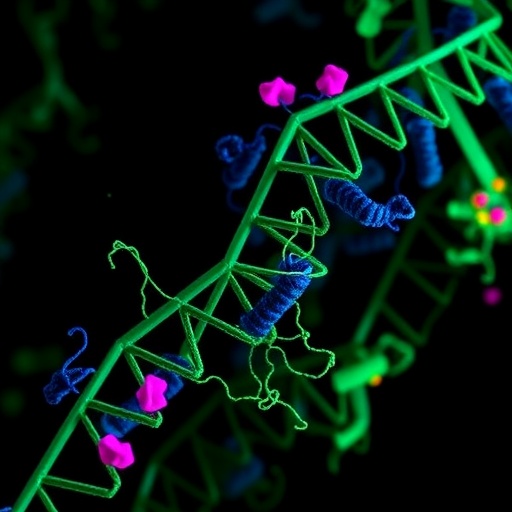In the relentless pursuit of understanding cancer biology, recent advances have illuminated crucial pathways that govern tumor progression and metastasis, particularly in ovarian cancer, which continues to pose a substantial challenge in oncology. Groundbreaking research conducted by Chen, Ren, Zheng, and colleagues reveals a significant role of long non-coding RNA HCP5 in facilitating malignant progression of ovarian cancer, a discovery that not only expands our understanding of tumor biology but also presents potential new avenues for therapeutic intervention.
Ovarian cancer remains one of the deadliest forms of cancer among women, largely due to its late-stage diagnosis and the complexity of its underlying biology. Traditional therapies have been met with limited success, emphasizing the need for innovative strategies that target the molecular intricacies of this disease. The study in focus sheds light on the inhibitory mechanisms of ferroptosis, a form of regulated cell death, highlighting how the interaction between HCP5 and polypyrimidine tract binding protein 1 (PTBP1) serves to impede this process, thereby promoting tumor survival and growth.
Ferroptosis has emerged in recent years as a distinct form of cell death characterized by iron-dependent lipid peroxidation. This type of cell death contrasts sharply with conventional apoptotic pathways, offering unique opportunities for therapeutic exploitation. The capacity to manipulate ferroptosis could fundamentally alter the treatment landscape for various cancers, presenting an emerging frontier in oncological research. Investigating the relationship between non-coding RNAs and ferroptosis could offer critical insights into tumor aggressiveness and resistance mechanisms.
The research team’s focus on the non-coding RNA HCP5 positions this molecule at the forefront of cancer biology. Long non-coding RNAs, once thought to be mere transcriptional noise, have now been implicated in a multitude of cellular processes including gene regulation, chromatin remodeling, and cell signaling. The findings from Chen and colleagues indicate that HCP5 is upregulated in ovarian cancer tissues, suggesting that it may play a pivotal role in the malignancy’s pathogenesis.
Through a series of innovative experimental approaches, the study establishes a compelling connection between HCP5 and PTBP1, a factor known for its roles in mRNA splicing and stability. Their interaction not only underscores the complexity of RNA biology but also hints at the potential for targeting these molecular interactions therapeutically. By inhibiting this pair’s function, there may be opportunities to enhance ferroptosis in ovarian cancer cells, thereby curtailing tumor growth.
Moreover, the implications of this study extend beyond ovarian cancer, as the dysregulation of ferroptosis has been implicated in several other malignancies. This research invites further inquiry into the broader role of long non-coding RNAs and their interactions with critical proteins in the regulation of cell death pathways. Understanding these relationships could foster the development of novel RNA-centric therapeutic strategies that target multiple dimensions of cancer biology.
In the context of translational research, the potential of harnessing long non-coding RNAs like HCP5 in clinical settings could redefine treatment protocols for ovarian and other cancers. As the scientific community continues to uncover the molecular underpinnings of these complex diseases, integrating these insights into therapeutic frameworks will be critical. The challenge remains to translate these findings from fundamental research into safe and effective clinical interventions.
Furthermore, the pathways involved in ferroptosis present unique challenges and opportunities. The possibility of inducing ferroptosis in cancer cells opens a new therapeutic window, particularly in cases where traditional therapies have failed. By elucidating the mechanisms through which HCP5 influences ferroptosis, this study may pave the way for the design of combination therapies that could circumvent resistance mechanisms commonly seen with standard treatments.
As the insights garnered from the Chen et al. study ripple through the oncology research community, it becomes increasingly clear that a multidisciplinary approach is essential for driving innovation in cancer therapy. Collaborative efforts that bridge molecular biology, bioinformatics, and clinical practice will be crucial in translating these findings into effective treatments for patients battling ovarian cancer.
In conclusion, this groundbreaking study not only sheds light on the pivotal role of HCP5 in ovarian cancer progression but also underscores the importance of investigating novel molecular targets in the fight against cancer. The revelation that long non-coding RNAs can significantly influence cell survival through mechanisms like ferroptosis could redefine our approach to cancer therapy, fostering the hope of more effective treatment options in the years to come. As research evolves, it will be vital to maintain a focus on the implications of these findings in both basic and clinical settings, ultimately enhancing our ability to manage and treat this formidable disease.
This research underscores the significance of innovative discoveries in the realm of cancer biology, illuminating paths previously obscured by conventional understanding. Emerging studies on the interplay between non-coding RNAs and fundamental cell death mechanisms provide a crucial scaffold upon which future therapeutic strategies can be built. With continued research and collaboration, the next breakthrough in cancer treatment may be just around the corner.
Subject of Research: Long non-coding RNA HCP5 in ovarian cancer progression
Article Title: Long non-coding RNA HCP5 accelerated malignant progression of ovarian cancer by inhibiting ferroptosis through interaction with polypyrimidine tract binding protein 1.
Article References:
Chen, X., Ren, Q., Zheng, X. et al. Long non-coding RNA HCP5 accelerated malignant progression of ovarian cancer by inhibiting ferroptosis through interaction with polypyrimidine tract binding protein 1.
J Ovarian Res 18, 271 (2025). https://doi.org/10.1186/s13048-025-01861-6
Image Credits: AI Generated
DOI: https://doi.org/10.1186/s13048-025-01861-6
Keywords: Long non-coding RNA, HCP5, ovarian cancer, ferroptosis, PTBP1, tumor progression, cancer therapy.




